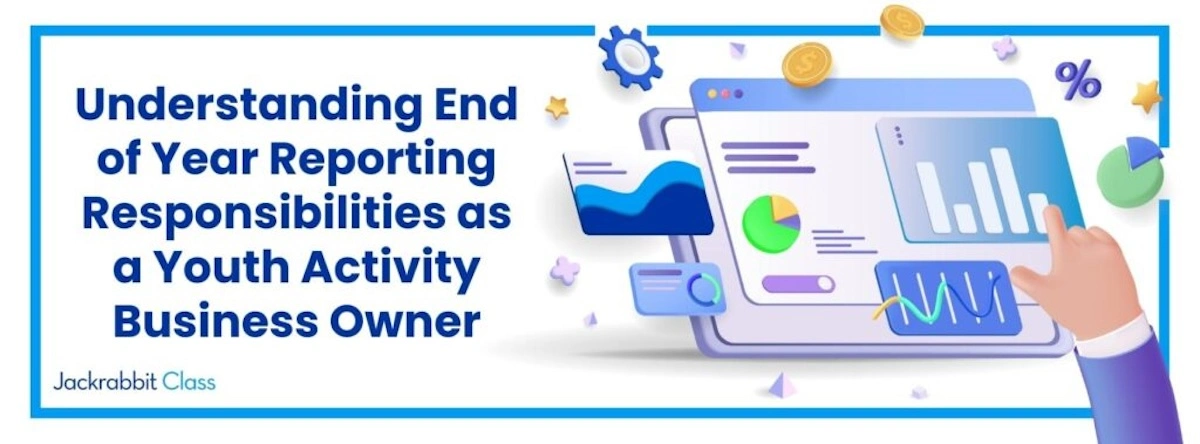As youth activity centers begin to prepare for the end of the year, the checklist continues to get longer and longer. One thing that is a ‘must’ for your end of year checklist is an end of year report. While it may seem like a daunting task, this is an important measure of annual success. Here are a few reasons why you should consider putting together an end of year report and what to include.
What is an end of year report?
End-of-year reports or annual reports are often used as a year-to-year measure of success.
- Did your school meet or exceed its tuition revenue goal?
- Did one location bring in more revenue than another?
- Did you see a jump in store revenue from last year to this year?
- Did revenue from events at your school surprise you?
Many business owners ask themselves these questions, gather important financial information, highlights from the year, and any other information that paints a picture of how the youth activity center worked towards the goals it set for the year. Many owners or managers will then provide this report to any stakeholders and use it as a reference for future years.
What kind of information is included in an end-of-year report?
Opening letter
As the creator of the end of year report, you will have a large hand in giving feedback and planning next year’s strategy. With an opening letter, take the time to give an overview of the contents of your report and address the stakeholders that will be reading this report. By opening with a high-level description of your conclusions, the stakeholders will begin their reading knowing what the report entails and have the background information needed to gain insight into your youth activity center.
Business Profile
If decision-makers and stakeholders don’t spend much time physically at your youth activity center, including a business profile in your end of year report is a great opportunity to provide contextual information to help bring them up to speed. Here are some things to consider including in this section:
- Mission, vision and values
- Staff members and changes in staffing over the last year
- Classes or camps offered
- Retail offerings
- Competitors
- Risks and opportunities
When completing this section, an important thing to remember is that your goal is to highlight key information that contributed to your yearly goals.
Management discussion and analysis
From one year to another, the changes in your business can be big or small, day to day, thought out or spur of the moment. This part of the report is often the most time-consuming. Take the time to review data and consider the decisions that you have made over the past year.
- Have you implemented new systems or processes?
- Did you have any issues that could have been avoided?
- Or have any big lightbulb moments?
The analysis portion of this section should be focused on linking changes to the effects they created.
- Did a new class offering cause a boost in revenue?
- Is a new teacher bringing in new students?
- Did your Staff Portal cause a decrease in administrative tasks?
These are the types of questions you can ask yourself as you write the management discussion and analysis.
It’s not a bad idea to consult others at your youth activity center before writing this section. Each role has different insight into the happenings at your business and will be able to give you feedback.
Financial
When it comes to finances, every youth activity center has their own preference for billing, reporting, and more. This section in your end of year report is one of the most important. It helps you gauge success over the last year and pivot any strategy for the future as needed.
Throughout the year, you should have pulled daily, weekly, and monthly reports. The financial reports you can include in this section are:
- Fee Summary report – what fees were posted?
- Paid Fees report – how much revenue and taxes were collected?
- Revenue Summary report – how much did you discount?
- Aged Accounts Detail – how much is still past due?
- Deposit Slip report – what kind of non-monetary credits did you give?
Pro Tip: Check out the Year-End Reporting Guide to see how to gather this information
After reviewing the included reports, highlight some things you want to draw attention to – whether it’s good or bad.
Now what?
Armed with information on why an end of year report is important and what it should contain, you are ready to begin your research and writing process. As the end of the year draws near, you want to give yourself enough time to complete the year-end report and consider changes and goals for the next year.
To make gathering data easier, utilize your class management software’s reporting features. If you aren’t currently using a class management software, implementing one could be a great upcoming goal.
Try Jackrabbit Class today and get 30 days free! You’re one step closer to making data-driven decisions easier.
Start a free trial






